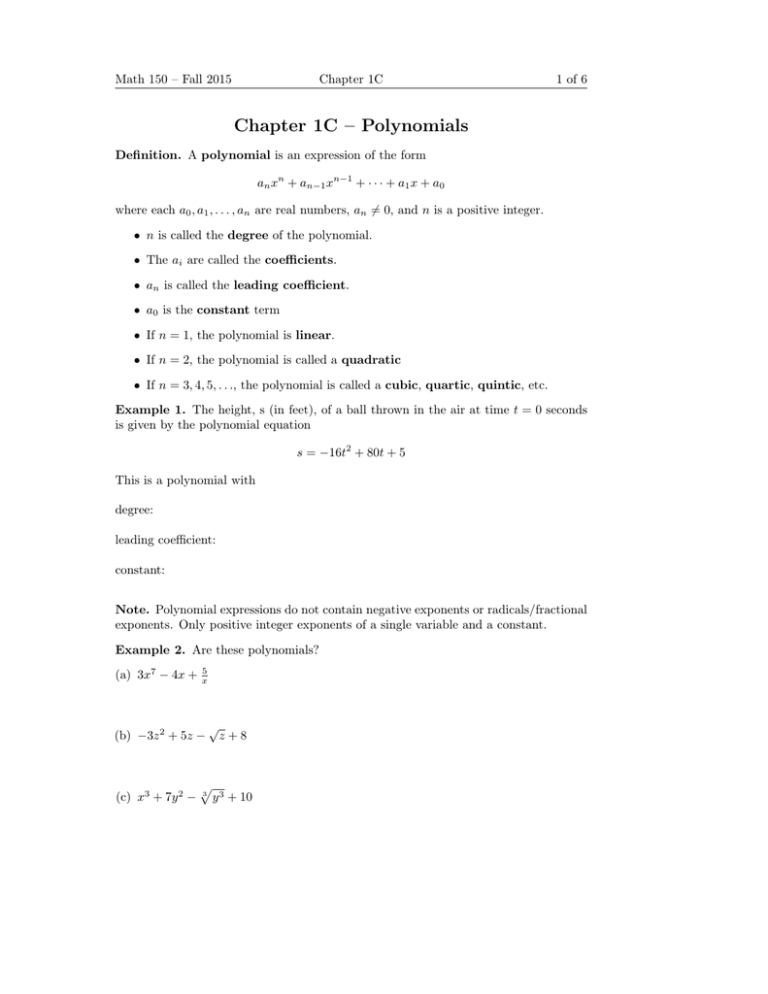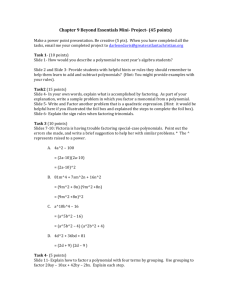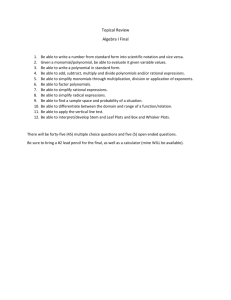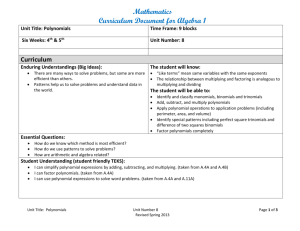Chapter 1C – Polynomials
advertisement

Math 150 – Fall 2015 Chapter 1C 1 of 6 Chapter 1C – Polynomials Definition. A polynomial is an expression of the form an xn + an−1 xn−1 + · · · + a1 x + a0 where each a0 , a1 , . . . , an are real numbers, an 6= 0, and n is a positive integer. • n is called the degree of the polynomial. • The ai are called the coefficients. • an is called the leading coefficient. • a0 is the constant term • If n = 1, the polynomial is linear. • If n = 2, the polynomial is called a quadratic • If n = 3, 4, 5, . . ., the polynomial is called a cubic, quartic, quintic, etc. Example 1. The height, s (in feet), of a ball thrown in the air at time t = 0 seconds is given by the polynomial equation s = −16t2 + 80t + 5 This is a polynomial with degree: leading coefficient: constant: Note. Polynomial expressions do not contain negative exponents or radicals/fractional exponents. Only positive integer exponents of a single variable and a constant. Example 2. Are these polynomials? (a) 3x7 − 4x + 5 x (b) −3z 2 + 5z − (c) x3 + 7y 2 − √ p 3 z+8 y 3 + 10 Math 150 – Fall 2015 Chapter 1C 2 of 6 Sums and Differences of Polynomials: Addition and subtraction of polynomials is done by combining like terms, that is, terms which have the same variable and exponent. Example 3. Simplify the expressions (a) 7x3 − 2x + 3 + x4 + 5x + 9 (b) 13x2 − x − 3x2 − 5x + 7 (c) − 13x100 + 500x53 + 3 − 10x100 − 400x53 + 50 Products of Polynomials: Multiplication of polynomials is based on the Distributive Property of the Real Numbers. Each term in the first polynomial is multiplied by the entire second polynomial. Example 4. Expand (multiply out) the following expressions. (a) (x − 7) (5x + 8) (b) (3x − 7) 5x3 − 7x2 − 4 (c) (a + b)(a − b) Math 150 – Fall 2015 Chapter 1C 3 of 6 Special Products: These are common products of polynomials that are useful to multiply or factor polynomials. Difference of Squares: Square of a Binomial: Sum of Cubes: Difference of Cubes: Cube of a Binomial: a2 − b2 = (a + b)(a − b) (a + b)2 = a2 + 2ab + b2 (a − b)2 = a2 − 2ab + b2 a3 + b3 = (a + b) a2 − ab + b2 a3 − b3 = (a − b) a2 + ab + b2 (a + b)3 = a3 + 3a2 b + 3ab2 + b3 (a − b)3 = a3 − 3a2 b + 3ab2 − b3 Note. There is NO special product (in the real numbers) for the sum of squares a2 + b2 Example 5. Expand the expressions (a) (x − 4)3 2 (b) [(x − 3y)(x + 3y)] Quotients of Polynomials: Division of polynomials is done using standard long division techniques: Divide, Multiply, Subtract, Bring Down, Repeat Example 6. Use long division to find 2372 ÷ 13 Example 7. Use long division to divide the polynomials: (a) 2x2 − 4x − 16 ÷ (x − 4) Math 150 – Fall 2015 Chapter 1C 4 of 6 (b) x4 + 3x2 − 8 ÷ (x2 − x) Factoring 1. Common Factors: A common factor is a factor of every term of an expression. Common factors can be pulled out of an expression using the distributive property in reverse. Example 8. Pull out the common factors: (a) x7 + 4x3 − 5x2 = (b) 6x3 y 5 z 3 − 8x2 y 3 − 12xy 6 z 2 = √ √ (c) 3x3 x + 5 + x x + 5 2. Factoring by Grouping: Factoring by grouping is useful when you have more than three terms in the polynomial. Factoring by Grouping separates the expression into groups and then uses common factors. Example 9. Factor 3x3 − 5x2 + 12x − 20 completely. Note. An expression is factored completely if it only has three kinds of terms left: √ 1. single factors (terms with no +): 7, x7 , y 8 , a,etc. 2. linear polynomials ax + b where a and b are relatively prime (have no common factors) 3. irreducible binomials: ax2 + bx + c (You must check that it actually is irreducible and cannot be factored) Math 150 – Fall 2015 Chapter 1C 5 of 6 3. Factoring Using Special Products We should check if the expression has the form of a special product. Example 10. Factor the expressions completely. (a) 5x2 − 80 (b) 16x4 − 54x (c) 3x4 + 75x2 (d) x3 + 9x2 + 27x + 27 4. Factoring Quadratics ax2 + bx + c • We want factors m and n with mn = ac and m + n = b. So we start by finding all the factors of ac and trying to find a pair that adds to b. • Split the middle term bx into two terms mx and nx and factor by grouping. Example 11. Factor completely. (a) x2 − x + 12 (b) 10x2 + 31x + 15 (c) 28x2 + 17x − 3 5. Factoring Out a Common Base to the Lowest Power: Example 12. Factor 5x3 y −2 3 7 + 30x2 y 3 Math 150 – Fall 2015 Chapter 1C 6 of 6 In general, you will need to use all the above techniques to completely factor expressions, and you will not be told which ones to use. Example 13. Factor completely. (a) 12x2 + 52x − 40 (b) 9x4 y 2 − 81x3 y 2 (c) 5x4 − 45x3 − 5x2 + 45 (d) 2x7 − 128x4 8 (e) 6x 5 y 2 − 24x −2 5







